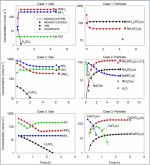Atmospher Sci & Global Chg
Research Highlights
October 2008
MOSAIC Adds a Piece to the Air Pollution-Climate Change Puzzle
PNNL's new atmospheric aerosol model produces accurate and efficient predictions of climate-relevant aerosol properties in record time.

Using different scenarios commonly found in the atmosphere, the PNNL team tested MOSAIC’s performance against benchmark models to determine how well it simulated the gas and particle concentrations. Each compound in the gas and particle phases is represented by a different color. These plots show—for three out of several test cases—the comparison results between MOSAIC/ASTEM (lines), MOSAIC/LSODES (filled circles), equilibrium ISORROPIA (filled triangles), and benchmark AIM (filled squares). These results help to prove that MOSAIC is extremely efficient without compromising accuracy, making it useful for air quality and regional/global aerosol models. Enlarged View
Results: The worldwide science community now has a better tool for investigating the effects of air pollution on climate change in regional and global models. A team of scientists led by Dr. Rahul Zaveri at Pacific Northwest National Laboratory has developed a new atmospheric aerosol chemistry computer model that combines both speed and accuracy—a combination currently unavailable in similar models. In addition to providing more accurate and realistic results, tests show that PNNL's model is more than 100 times faster than a rigorous solver that was used as a benchmark.
The Model for Simulating Aerosol Interactions and Chemistry, or MOSAIC, is PNNL's contribution to the chemistry version of the Weather Research and Forecasting model, WRF-Chem. WRF-Chem is a three-dimensional model that simulates important climate feedback processes, such as interactions among air pollution or natural trace gases and aerosol particles, water in clouds, and sunlight, simultaneously with changes in meteorology. MOSAIC is the "jet engine" that powers the trace gas photochemistry and aerosol thermodynamics, chemistry, microphysics, and dynamics computations in WRF-Chem. MOSAIC is now accessible in WRF-Chem and available in a stand-alone format.
Most available aerosol models use "bulk equilibrium" or "hybrid" approaches where the simulated aerosol particles of different sizes are artificially lumped together and treated similarly regardless of their chemical composition, thus leading to inaccurate results. In contrast, MOSAIC distinguishes the particles by size and chemical composition and accounts for the numerous chemical and microphysical processes, including how they continuously interact with different gases. MOSAIC is also extremely computationally efficient. For example, using MOSAIC, it took less than one day of computer time on a common desktop workstation to simulate three days of aerosol and smog chemistry in the Los Angeles Basin. In comparison, a benchmark rigorous solver would take more than 100 days of computer time on the same workstation to simulate the same three days of Los Angeles Basin smog with similar accuracy.
Why it Matters: Air pollution and climate change can affect our health, crops, and wildlife. Knowing how aerosols develop, transform, and move in the atmosphere can help scientists determine particle properties and concentrations, which in turn have large effects on cloud formation, regional haze, and atmospheric cooling or warming at regional and global scales. Aerosol modeling is difficult because particle sizes can vary and be composed of many different compounds such as ammonium sulfate, nitrate, organics, sea salt, mineral dust, and soot. Aerosols play such an important role in climate change that having an accurate and efficient aerosol module becomes an essential piece in the challenging puzzle of accurately predicting the effects of air pollution on climate change.
Methods: To assess MOSAIC's performance, the researchers evaluated it against other benchmark models.
What's Next: The PNNL team led by Dr. Rahul Zaveri continues to enhance MOSAIC, including reducing the amount of time it takes to run. Dr. Zaveri also plans to collaborate with scientists at National Center for Atmospheric Research and University of California, Davis, to develop an improved treatment for secondary organic aerosols and their processes, which are presently not well understood and poorly represented in atmospheric prediction models.
Research Team: Rahul A. Zaveri, Richard C. Easter, and Jerome D. Fast, PNNL; and Leonard K. Peters, formerly with Battelle.
Acknowledgments: PNNL is transforming the Nation's ability to predict climate change and its impacts. The overall MOSAIC software architecture was developed by PNNL scientists with major funding from the U.S. Department of Energy's Office of Biological and Environmental Research and from National Aeronautics and Space Administration Earth Science Enterprise.
Citation: Zaveri, R.A., R.C. Easter, J.D. Fast, and L.K. Peters. 2008. "Model for Simulating Aerosol Interactions and Chemistry (MOSAIC)." J. Geophys. Res., 113, D13204, doi:10.1029/2007 JD008782.
